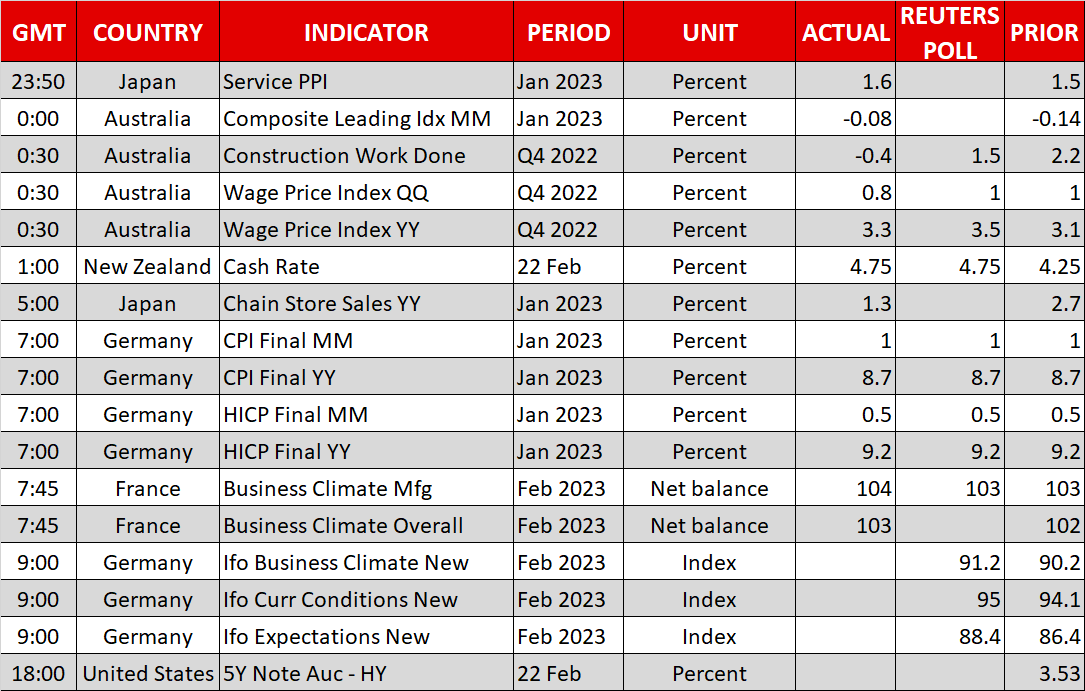- Dollar strengthens as better PMIs add to Fed hike bets
- Eurozone and UK PMIs also surprise to the upside
- Equities and risk-linked currencies feel the heat of hike bets

Better PMIs fuel Fed hike bets and the dollar, Fed minutes on tap
The dollar traded higher against all but one of the other major currencies yesterday, although it is trading mixed today. The only currency against which the greenback lost ground was the British pound.
Following a streak of upbeat economic data from the US, but also hotter-than-expected inflation numbers for the month of January, investors have dramatically revised up their expectations on the path US interest rates are likely to follow and yesterday, the preliminary S&P Global PMIs added extra credence to that view. Both the manufacturing and the services indices improved by more than expected, and although the former stayed in contractionary territory, the latter climbed above 50 for the first time since June, lifting the composite index into expansionary zone as well.
With inflation appearing stickier than previously expected and economic data continuing to surprise to the upside, market participants are now expecting interest rates to peak at around 5.35% in July, while they see them ending the year at 5.15%. This means that should the Fed match its December median projection for the year, no cuts will be warranted this year.
That said, some policymakers have already expressed the view that interest rates should have been raised more at the last meeting and argued about a higher terminal rate than the December dot plot suggested. Therefore, with that in mind, traders may pay extra attention to the minutes of the last Fed gathering, scheduled to be released later today.
Although the meeting took place before the upbeat data, more policymakers expressing preference about higher rates could increase the chances for the median projection for 2023 to be revised up in March. This could add extra fuel to the dollar’s engines, but calling for a full-scale bullish reversal is still premature as investors have raised additional hike bets with regards to other major central banks as well.
Eurozone and UK PMIs also beat expectations, pound the main gainer
One of them is the ECB. Ahead of the US PMIs, we got the Euro area indices which were also largely better than expected, with the composite PMI rising to 52.3 from 50.3 and adding to hopes that the Eurozone may avoid a previously feared recession. Combined with underlying inflation not showing any signs of slowing, this gives the green light to the ECB for continuing raising interest rates aggressively.
According to money markets, investors have now raised bets for a triple hike at the next ECB meeting, while they expect the terminal rate to be 30bps higher compared to last week’s pricing. Should next week’s inflation data show that underlying inflation remained elevated in February, ECB hike bets are likely to increase, which will complicate things for euro/dollar sellers.
Up until yesterday, euro/pound seemed a better pair for exploiting any euro strength, but the UK PMIs also surprised to the upside, with the composite index jumping to 53.0 from 48.5, returning to growth territory for the first time since July and adding to hopes that Britain may be on course to bypass a long recession. The pound was the best performing currency due to that, but it may not be out of the woods yet, as the BoE is still expected to proceed much more carefully than the ECB and the Fed with future rate hikes.
Wall Street sees worst day for 2023, risk-linked currencies also slide
Increasing expectations of more aggressive tightening by the Fed, but also from other major central banks like the ECB, hurt equities yesterday, with all three of Wall Street’s main indices falling by more than 2% each. The more rate-sensitive Nasdaq tumbled 2.50% as expectations of higher interest rates, not only mean higher borrowing costs for companies, but also lower present values for high-growth tech firms as they are usually valued by discounting future profits.
The risk-linked currencies aussie, kiwi, and loonie were also down due to the deteriorating risk appetite, with the loonie losing the most ground after data showed that Canadian inflation slowed more than expected in January, congealing expectations that the BoC may refrain from hiking rates further at its upcoming gathering.
The kiwi managed to gain some ground today after the RBNZ hiked rates by 50bps and noted that further tightening is needed due to core inflation remaining too high. However, with risk sentiment continuing to deteriorate during the Asian session today, the currency was quick to give back a large portion of its RBNZ-related gains.
